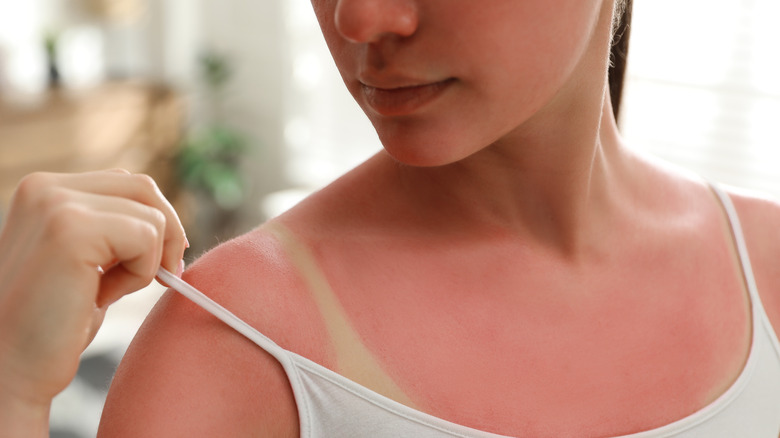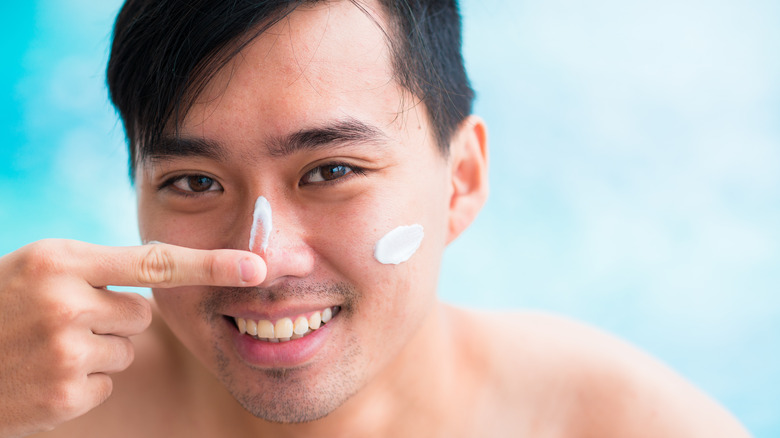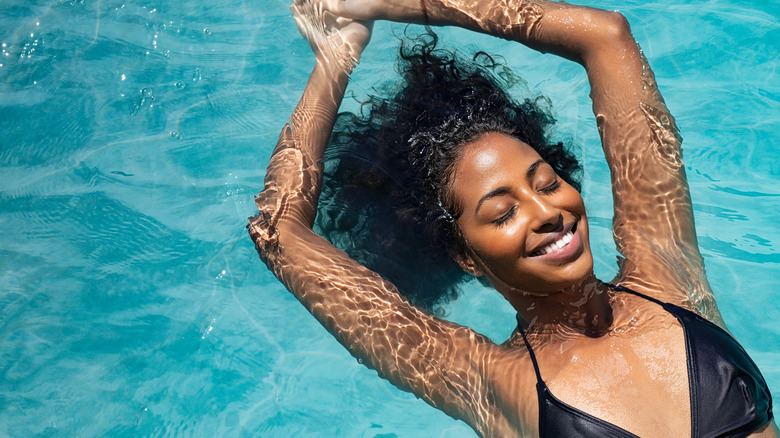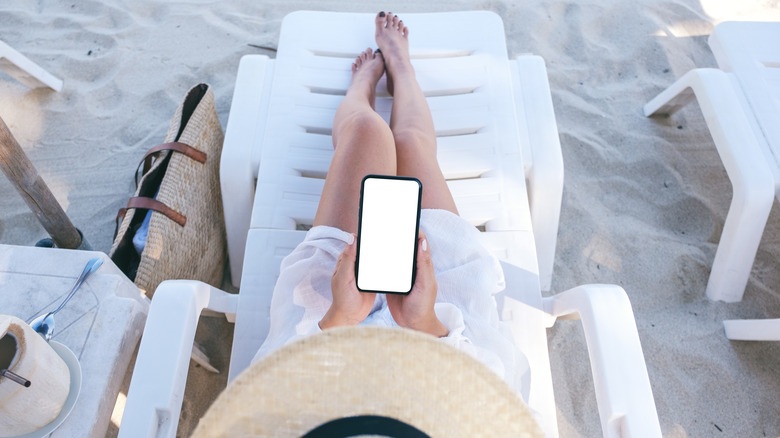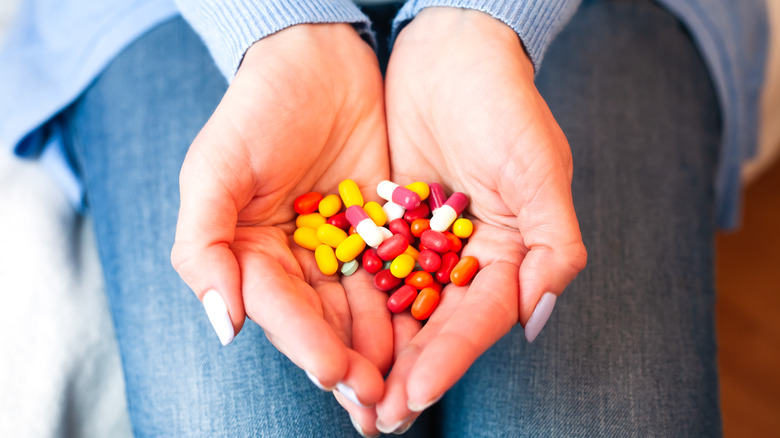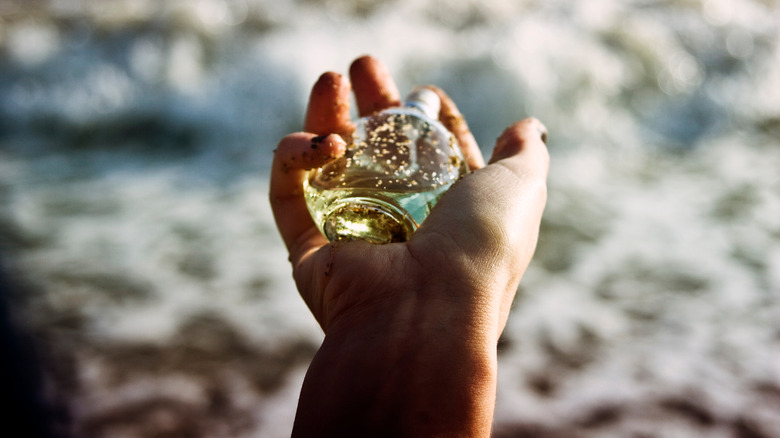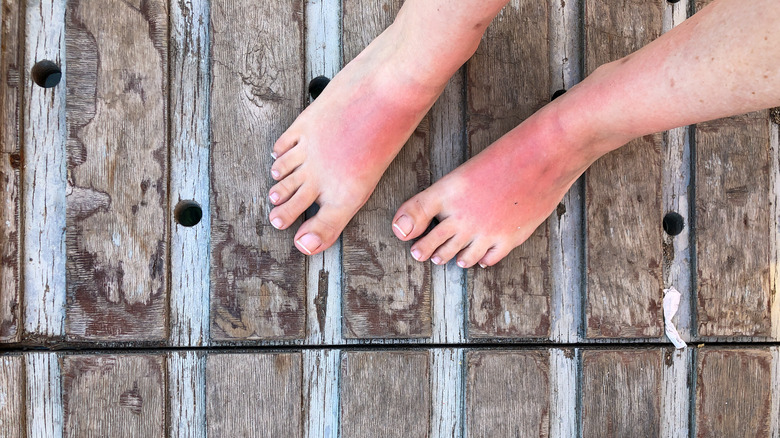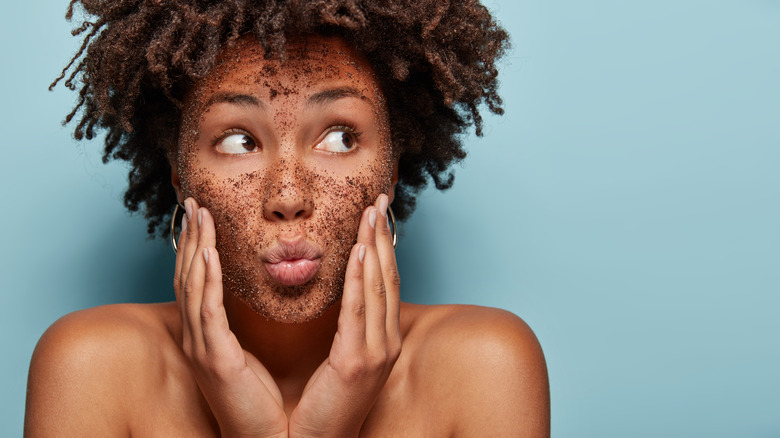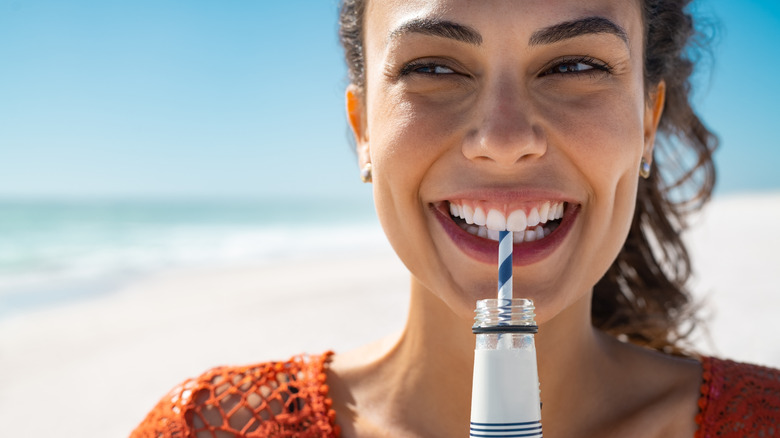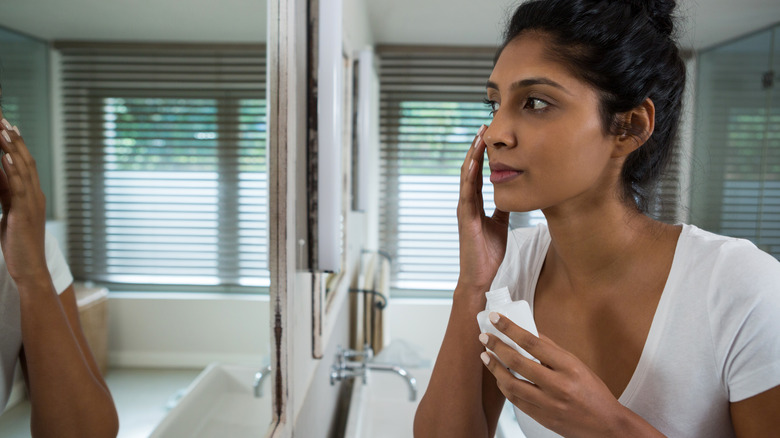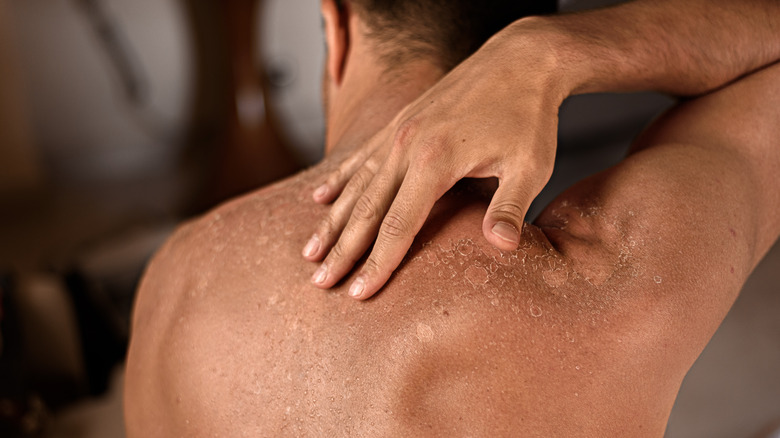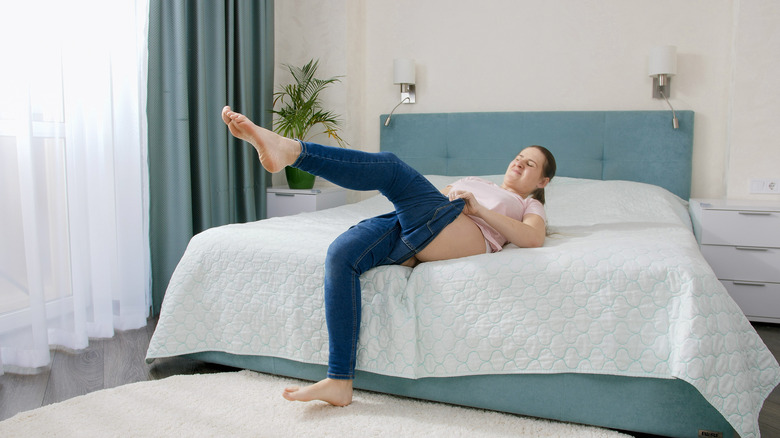Mistakes That Will Make Your Sunburn Even Worse
Time in the sun can be an awesome mood booster (via Healthline). The sun warming your face, the delightful scent of coconut from your sunscreen, a cool drink in your hand, and a soft breeze on your body. Who doesn't want that?
Well, there's this pesky thing called skin cancer, and that's where things can go terribly wrong and sneak up on you when you least expect it. Every year, more than one out of every three Americans reports getting a sunburn, according to the Office of the Surgeon General. Not surprisingly, sunburn is linked with skin cancer. Skin cancer occurs from overexposure to ultraviolet (UV) light and it is the most commonly diagnosed cancer in the United States affecting 5 million people each year. So, yes, it is a very big deal.
But it's not all doom and gloom. Let's learn how to get ahead of the curve and avoid the most common mistakes, so you can enjoy your days in the sunshine without experiencing the more serious consequences.
Mistake: Solely depending on sunscreen for protection
A few dollops of sunscreen and you're good to go, right? Turns out the answer is a big "nope!" If you are sun-sensitive (translation: anyone who gets even mildly pink in the sun), you're among the group who even with rigorously applied sunscreen still suffer the most burns, according to a 2018 study (via Reuters). A whopping 62% of SPF-slathered respondents experienced sunburned skin more than any other group, even those who wore no sunscreen at all but employed other sun-avoidance actions such as wearing hats or seeking shade.
"When used properly, sunscreen blocks UV rays," explained Kasey Morris of the National Cancer Institute in Bethesda, Maryland, the study's conductor, explained to Reuters that sunscreen does effectively block out UV rays, but application is key. People oftentimes apply too little or too infrequently for it to do its job properly.
When planning a day outside, be sure to spend more time in the shade and wear a wide-brimmed hat. A multifaceted approach is key for success, in combination with a broad-spectrum SPF reapplied every two hours or more frequently if sweating or swimming (via Southcoast Health).
Mistake: Not wearing sunscreen if you have darker skin
If your skin already has a lot of pigment, or melanin, to provide a natural barrier from ultraviolet (UV) rays, you may think it's a little counterintuitive to need sunscreen. However, that built-in protection is not very strong. "Darker skin contains more melanin than lighter skin, and that helps block the rays from penetrating and doing as much damage," Dr. Maritza Perez, a clinical professor of dermatology at the Icahn School of Medicine at Mount Sinai in New York City, told Consumer Reports. "But even the darkest Black skin provides only about an SPF 13. If you get enough sun exposure, you'll get skin damage, and possibly even skin cancer."
Additionally, a 2018 study published in the JAMA Dermatology Journal revealed that despite being at generally lower risk for skin cancer, Black and Hispanic groups have a high incidence of sunburn due to forgoing sunscreen. The chalky finish of some sunscreen formulations is a commonly cited reason that consumers with darker complexions say they skip sunscreen (via CNN). Luckily, though, today's variety of products now include those that won't leave that mineral residue while still being highly effective. The bottom line is that everyone, regardless of skin color, is at risk of sunburn, skin cancer, and premature aging, so the daily application of sunscreen is essential.
Mistake: Using your smartphone or tablet in the direct sun
Okay, let's get real. A lot of us are guilty of kicking back at the beach with our tablet or smartphone in hand. But did you know that the indirect light bouncing off the screen magnifies the effect of damaging UV rays on your face, neck and chest?
In a study published by the Journal of the American Academy of Dermatology, the reflected UV exposure from electronic devices had negative consequences on skin health. An iPad 2 screen increased reflected UV light by 85%, while an iPhone 5 showed a 36% rise in exposure (via Reuters Health). "The harmful effects of UVA and UVB rays have been well documented, and limiting exposure is the single most effective preventive measure an individual can take," Mary E. Logue of the University of New Mexico in Albuquerque, who co-authored the research, told Reuters. "Significant levels of UV exposure, such as those found in this study, increase cumulative lifetime UV dosage."
Reducing these risks from your mobile devices can be as simple as wearing sunglasses and broad-spectrum sunscreen, and also seeking cover from an umbrella or shaded patio. Better yet, put your cell phone down for a bit! It's liberating to connect with your surroundings.
Mistake: Not realizing your medications increase sun sensitivity
Your allergy medicines and nonsteroidal anti-inflammatory drugs (NSAIDs) may make you more prone to sunburn. Yes, it's true — a whole host of common drugs can play havoc with your skin, including diuretics for blood pressure, antibiotics, and antidepressants (via WebMD). Photoreactive properties in some of these medications can cause photosensitivity. Results can be dramatic, including rashes or even really bad sunburns that may not appear until after a day or so.
"People with fair skin, blond or red hair, and blue eyes are more sensitive to sunlight in general," Dr. Anthony Fernandez, a dermatologist with the Cleveland Clinic in Ohio, explained to Cleveland Clinic Health Essential. "However, anybody can get an exaggerated sunburn due to medications, regardless of skin color."
How do you know if your prescription or over-the-counter drugs cause photosensitivity? Read the warning labels on the packaging, and consult with your doctor or pharmacist. "Ideally, people should avoid prolonged exposure to sunlight while using one of these medications," Gail Newton, associate professor of pharmacy practice at Purdue University, told Purdue News. If outdoor time can't be avoided, wear a generous layer of broad-spectrum sunscreen and reapply it often, don a hat and clothing that covers the skin, and try to stay out of the sun's strongest rays that occur between 10 a.m. and 4 p.m.
Mistake: Thinking all sunglasses are created equal
What's the first thing you think when you're shopping for a new pair of sunglasses? Chances are it's more about fashion and frames than the quality of the lenses. That's a mistake. The truth is that the lenses are really, really important to your eye health. An American Academy of Ophthalmology (AAO) survey showed less than half of sunglass wearers check the UV rating before making a purchase.
When it comes to kids and the sun, even the most doting parents can miss the mark. While 74% will make sure their little ones are covered head to toe in sunscreen, many neglect the equally important sunglasses. The AAO's 2014 Harris Poll of U.S. adults showed less than a third ensure their children wear UV-protected sunglasses.
Eyes can be damaged by the sun's ultraviolet radiation, just like your skin. Prolonged exposure can lead to reduced vision from cataracts and macular degeneration (via Johns Hopkins Medicine). So how do you know if you have a quality pair of specs? One thing's for sure: Don't judge them by the darkness of the lens. Instead, look for a tag or sticker that shows "100% UV protection," "UV400," or "UV absorption up to 400nm," advised All About Vision. The color of the lens doesn't have any impact on how much UV light it blocks, asserts the AAO. Fortunately, you don't have to spend a lot of money to get UV-protective sunglasses. Your local drugstore will likely have what you need.
Mistake: Underestimating the power of a 'margarita burn'
Blending up margaritas or slicing limes for cervezas? Well, be sure to wash your hands not only before but after the drinks are served. When you expose some citrus fruits (especially limes) to prolonged sunlight, there's a phototoxic reaction called phytophotodermatitis (aka a "margarita burn") that can really do a number on your skin, according to a paper published in Proceedings (Baylor University Medical Center). It happens when furanocoumarins (chemical compounds in limes and certain other plants) react to UVA light, which creates discolored lesions or clusters of fluid-filled blisters on exposed skin. The resulting damage can look like second- or third-degree burns and take months to heal (via Healthline).
"You might need supportive care like you would for sunburn, including cool compresses, anti-inflammatory medication (like ibuprofen), or topical steroids. People with severe blistering or skin that's sloughing off will face a risk of secondary infection, so it needs to be treated like a burn," says Dr. Keira Barr, a dual board-certified dermatologist and founder of Resilient Health Institute, told Healthline.
What's the best way to avoid this cocktail horror show? Wash your hands and any other parts of your body that have come into contact with plants that have those reactive compounds. And, of course, always wear sunscreen and reapply it often.
Mistake: Remaining in the sun long after your skin turns pink
You're having a good time with friends and the day still feels young! Before you know it, many hours have passed under the hot sun. One of your friends mentions you're looking a little pink on the shoulders, but you shrug it off. But later that night, those barely pink shoulders have turned into a full-blown lobster-red sunburn. Ouch!
How could that tiny bit of pink turn into such an unsightly and painful burn? It's because the burn really does keep on cooking even after you've called it a day. "We discovered that in addition to this instantaneous damage, the cells continue to make DNA damage for hours afterward," revealed Douglas E. Brash, co-author of a Yale-led study and senior research scientist in therapeutic radiology and dermatology at Yale School of Medicine (via Allure). He added, "UV rays trigger free-radical chemistry that excites an electron in a fragment of melanin to a very high energy. The energy goes into DNA and causes damage."
After getting a sunburn, you can't literally turn back time to get out of the sun; however, there is something you can do to hopefully prevent further the free-radical damage. Antioxidants such as Vitamin C and E, ferulic acid phloretin, and resveratrol can help. Joshua Zeichner, director of cosmetic and clinical research at Mount Sinai Hospital in New York City told Allure, "Traditionally we recommend antioxidants in the morning and daytime to prevent damage, but perhaps given this data we should be incorporating them in the evening as well."
Mistake: Finishing your beach look with a spritz of fragrance
Just before you step out the door for a day at the beach, you spritz your wrists, neck, and rest of your body with your favorite perfume. Little did you know that's not a good move!
Perfumes "often contain the chemical sensitizer bergapten," Dr. Susan Massick, a board-certified dermatologist and associate professor of dermatology at the Ohio State University Wexner Medical Center in Columbus, told U.S. News & World Report. When those compounds found in fragrance are applied directly to the skin and then baked under the sun's rays, there's a potential for some very nasty consequences.
"When UV light hits [certain chemicals], it causes a reaction like an explosion in the skin, and you get damage, " added Dr. Bruce Robinson, a board-certified dermatologist and clinical professor of dermatology at Lenox Hill Hospital in New York City. The result can be a mottled skin appearance called hyperpigmentation or even a significant burn that causes redness, swelling and blistering, known as a phototoxic reaction. Moral of this story: If you must wear fragrance, spritz it on your clothing and avoid putting it directly on your skin.
Mistake: You did a patchy job applying sunscreen
Have you ever applied sunscreen to your eyelids? Your ears? How about where you part your hair? If you don't, or rarely do, you're not alone. Yet these areas and more, such as your lips, the tops and bottoms of your feet, between your toes, the back of your hands, and even your fingertips are all fair game to UV damage and eventual skin cancer, reported Health.
"There is compelling evidence that repeated sunburns, especially when suffered in childhood, portend a significant increase in risk for some of the worst cancers of the skin," says Dr. Adolfo Fernandez-Obregon, a board-certified dermatologist practicing in New Jersey, told the Skin Cancer Foundation. One especially surprising place for cancer to hide is on the soles of the feet, palms of the hand, and under the nails. Though rare, acral lentiginous melanoma is easy to miss because of the unlikely location (via WebMD). The condition is found more often in people with darker skin.
Combat all of the above by applying sunscreen to every bit of exposed skin, even the less typical areas of concern. Mineral sunscreen is a good choice for around the eyes, as well as an eye cream with SPF. Dr. Debra Jaliman, a New York dermatologist told Health, "They are safer to use around the delicate eye area than other sunscreens, and won't burn or sting if it happens to get in the eyes."
Mistake: Using exfoliating products too soon after a burn
While it is tempting to rush your skincare routine to speed healing after getting a bad sunburn, keep in mind your skin is in a very delicate state. You can do more harm than good if you use exfoliating scrubs or other aggressive products.
Sunburn is your skin's reaction to too much of the sun's UV radiation. Most sufferers will experience red, dry, and itchy skin. It might be puffy, and the skin will likely be hot and tender to the touch. What your skin is screaming out for when it's in this sad condition is moisturizer, especially one containing aloe vera or soy (via American Academy of Dermatology Association). Dr. Michele Farber, a board-certified dermatologist, told NBC News that "a plain, unscented moisturizer" is helpful.
"Do not pull off your peeling skin, and avoid active exfoliation," Dr. Natalie Curcio, a board-certified dermatologist in Nashville, Tennesse, advised in an interview with the Skin Cancer Foundation. "Instead, allow it to slough off your body on its own." Be kind to your raw, sunburned body and give it time to heal.
Mistake: Starving your irritated skin of hydration
Your skin is mostly made of water, so hydration is an oft-repeated theme when it comes to healing a sunburn. When the skin is raw and irritated from UV rays, it draws fluids away and you need to replace them fast to avoid dehydration, according to the American Academy of Dermatology.
In an article for the Washingtonian, Dr. Elizabeth Tanzi, co-director of the Washington Institute of Dermatologic Surgery and a board-certified dermatologist, encouraged immediate hydration by drinking water and applying pure aloe vera gel to skin to replace fluids and nourish the damaged skin. In fact, aloe vera applied to damp skin after a cool shower is an effective way to provide quick relief and aid recovery, according to Beaumont Health. By leaving some water on the skin, it helps the epidermis reabsorb moisture.
With skin being comprised of 64% water, and water being the building blocks of cells, it should be no surprise that good ol' hydration is the key to restoring skin and body to a healthy, not sunburned, glow.
Mistake: Applying the wrong lotions to a sunburn
When your skin is itchy and inflamed from the sun, you might think that applying topical numbing creams like benzocaine or lidocaine would be a good first step. Don't do it!
Dr. Andrea Garrett, a board-certified dermatologist advises against using any products ending in "caine" for sunburn because they may be irritating to the skin (via Forefront Dermatology). In fact, the Mayo Clinic reports that topical anesthetics like benzocaine even carry a rare but real risk of decreasing blood oxygen levels on raw or blistered skin. Another no-go for sunburns is Vaseline and other petroleum products, according to Medline Plus. These thick oil-based products are a mixture of mineral oils and wax that can actually block pores and trap heat on the skin and cause infection.
Instead of all the above, the Centers for Disease Control and Prevention suggests using a low-dose over-the-counter hydrocortisone cream of 0.5 to 1% to relieve burning and swelling in combination with an aloe moisturizer to aid the healing process and hydrate skin.
Mistake: Picking at your flaking or blistered skin
There's just something a little tempting about peeling off patches of dry unsightly sunburned skin. But, please don't. Peeling or picking at your flaking skin before it's ready to break away on its own will just increase your chances of infection and further skin damage. "Peeling sunburned skin can increase the risk for scarring because the skin does not always peel at the same rate," Dr. Debra Wattenberg, a New York City dermatologist board-certified with the American Academy of Dermatology, told Good Housekeeping. "It's best to let the dead skin exfoliate on its own."
"Let the flaking skin fall off naturally," Dr. Keith LeBlanc Jr., dermatologist and founder of The Skin Surgery Centre, advised The Healthy. "Even better, generously moisturize your skin with the product of your choice. This will improve the appearance of the sunburn and help the skin to exfoliate naturally and evenly."
Additionally, avoid popping blisters. They're annoying, yes, but you should leave them be. A blister is essentially a cushion that protects the raw skin underneath from infection (via How Stuff Works).
Mistake: Wearing tight clothing over your burn
Your legs and arms and, well, everything, feels like it's on fire. You're realizing maybe it wasn't such a brilliant idea to spend the entire afternoon on the lake. But now what are you going to do? You've got places to go and people to see, and your favorite pair of jeans are calling out to you. You really shouldn't answer.
"Wearing tight clothing over sunburned skin is an absolute no-no, because inflammation is setting in," Dr. Shereene Idriss, a dermatologist at Union Square Laser Dermatology in New York, told The Healthy. "Your body is trying to respond to the trauma by increasing blood flow to the area to help with healing. This results in redness, warmth, and inflammation to the area."
Loose garments are the best choice for keeping your sunburned skin cool and comfortable. Vanguard Dermatology in New York City recommends tightly woven fabrics you can't see through, preferably in dark or bright colors, for superior ability to block the sun's rays. Bottom line: Keep it cool and loose — and forget the jeans!

